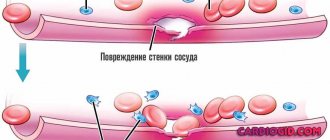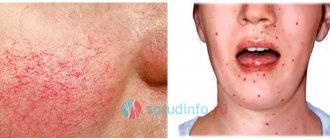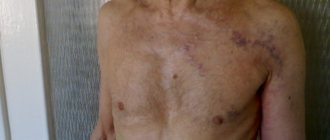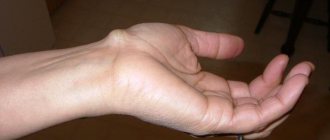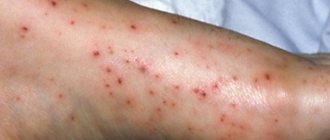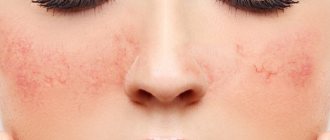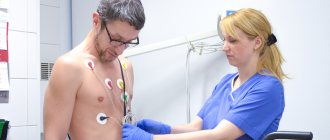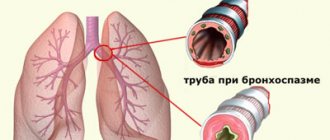Causes
The main reason for the formation of rosacea on human skin is local expansion of the corresponding vessels or pronounced thinning of the epidermis, which leads to their translucency. There are quite a few pathological and physiological conditions that can cause such changes.
Factors that provoke the appearance of a capillary network:
- Chronic diseases of the cardiovascular system.
- Excessive dryness of the skin against the background of atrophy of its upper layer.
- Venous insufficiency. Reticular patterns often appear with corresponding pathology of the lower extremities. They can be considered harbingers of varicose veins.
- Hormonal imbalance.
- Pregnancy.
- Genetic predisposition.
The causes of capillary mesh on the face, legs and other parts of the body can be intertwined. It is not always possible to accurately determine the main factor provoking the pathology.
Additional situations that increase the chance of experiencing the corresponding symptom are:
- Smoking.
- Overweight.
- Excessive physical activity (big sports).
- Constant stress load.
All these factors affect the general well-being of a person and indirectly take part in circulatory disorders and a decrease in the elasticity of the vascular wall.
What are spider veins?
Spider veins are the outward manifestation of dilated blood vessels. They usually appear on the face, legs and sclera of the eyes.
Their dimensions are 0.5-1mm. About 30% of the population has spider veins, and most of them are women. Vasodilation can be either congenital or acquired.
The formation of stars is associated with dilation and enlargement of venous capillaries, but this is not always a sign of varicose veins or thrombosis.
Telangiectasia does not always appear with these diseases.
This defect in itself is not a disease and does not pose a threat, and it is removed for aesthetic reasons.
There is a classification of spider veins according to their manifestations and origin.
According to their manifestations they can be:
Linear stars usually appear on the cheeks, nose and inner thighs and are reddish in color. This is the most common type of telangiectasia, which usually does not pose a threat, but causes psychological discomfort. Tree-like formations appear on the lower extremities from the outside.
Asterisks in the shape of a spot often signal serious pathologies:
By origin they are divided into:
- Arterial.
- Capillary.
- Venous (thread width more than 0.02 mm).
Despite such a variety of types, treatment is carried out using the same methods. The easiest way is to remove capillary stars, which often appear on the face. Some educations take place on their own within six months.
Localization
Capillaries penetrate the entire human body. This affects the localization of the pathological process. A capillary network can appear on the skin of any part of the body. Much depends on a person’s lifestyle, the characteristics of his body, and genetic predisposition.
For example, sedentary work or standing in one place for a long time will lead to the appearance of a capillary network on the legs. Excessive exposure to the sun will cause the formation of a visual defect on the face.
The most common mesh localizations are:
- On the chest.
- On the stomach.
- On foot.
- On the face (cheeks, wings of the nose, area under the eyes).
- On the back.
Local expansion of capillaries on the body may be a symptom of more serious diseases of the internal organs. The appearance of a mesh on the skin sometimes indicates a violation of the protein-synthetic function of the liver.
The visual defect can be localized in the abdomen and migrate to the lower back. If a mesh appears on the chest, you should additionally undergo examination by a rheumatologist. Some vasculitis and systemic connective tissue diseases may also be accompanied by a corresponding change in vascular elasticity.
What type of treatment do you prefer?
- Allergy. Occurs on food products, dust, animal hair, and hygiene products. Severe allergies are accompanied by swelling of the mucous membranes, causing a runny nose and cough. When you first encounter an allergy, think about the state of the immune system: it perceives harmless substances as hostile, works hard and becomes exhausted.
- Stress, one-time or chronic. Increased nervous tension causes hypertonicity of small vessels, hence the appearance of red dots. If you are experiencing stress, chronic tension, depression, take a break and consult a psychologist. It’s not without reason that doctors say: “All diseases come from nerves.”
- Lack of vitamins C and K, which ensure the elasticity of blood vessels. Hypovitaminosis makes the capillaries fragile, the red spots are tiny micro-effusions that mark the places of ruptures. A balanced diet and a course of multivitamins will help solve the problem.
- Rosacea. Bright pink acne affects the face, neck, and sometimes chest, and is found among all categories of the population. Women suffer especially often during pregnancy and menopause, which is again caused by hormonal changes. Rosacea causes a lot of psychological troubles; Local antibiotics help relieve itching and swelling. The causes of rosacea are the subject of medical controversy; treatment will require an examination of the digestive system, checking the state of the immune system, and taking scrapings for demodicosis.
- Human papillomavirus. It occurs in the majority of the world's population, and is especially dangerous for women. The virus can remain dormant for a long time, beginning an attack during periods of special stress (for example, pregnancy) or weakened immunity. Papillomas vary in shape and size, some affect the woman’s genitals. Papillomas are safe, but with a general deterioration of the condition they can provoke cervical cancer. Having diagnosed papillomas, you need to constantly monitor their condition.
Varieties
Cuperosis on the body is one of the types of telangiectasia. The more common name for this phenomenon for people remains “spider veins”. Depending on the initial type of affected blood tract, they are:
The capillary network on the legs most often belongs to the third type of spider veins. The defect on the body is usually of a mixed nature. The formation of mesh on the face is mainly due to the expansion of capillaries.
Depending on the visual features, the following types of telangiectasias are distinguished:
Varieties of the corresponding pathology mainly do not affect the process of their treatment. You can get rid of the problem using conservative or minimally invasive surgical methods. It all depends on the characteristics of each clinical case.
Classification of histological structural formations
| Structure | Manifestations |
| Capillary (simple) - the most common type | Less symptomatic. They have different sizes, consist of intertwined formations of vessels and capillaries, the walls of which are thin, while the channels are separated by adipose and fibrous tissue. They are arranged in several layers. |
| United racematous branches | Characterized by the presence of a connected formation of venous or arterial vessels |
| Cavernous hollow structure | It appears painful. It represents several cavities that are separated by thin hypertrophied connective tissue septa. The walls of blood vessels do not have elastic fibers. Feeds one or more large vessels |
| Mixed | The structure will depend on the volume of the lesion, and will include thin-walled capillaries, large vessels of enlarged cavities |
Depending on the location of the development of the pathological process of hemangioma in the anatomical structures of the vertebra, the degree of damage is distinguished: localized and isolated, when the entire vertebra is affected, only its body, the body and the posterior semi-ring, the spinal cord canal. The increase in education is determined by dynamic criteria.
Manifestations
The appearance of a vascular network on the body can be completely invisible to the patient. The root cause of a specific visual defect plays a key role in the clinical picture.
Capillary mesh on the legs caused by varicose veins will be accompanied by the following symptoms:
- Edema.
- Heaviness in the legs.
- Change in color of the spider vein from red to purple.
The mesh, which develops against the background of liver failure, may be accompanied by other manifestations of dysfunction of the corresponding organ:
- General weakness.
- Yellowing of the skin.
- Weight loss.
- Impaired consciousness and others.
In most cases, capillary mesh does not cause much discomfort. They create a visual defect that can be easily corrected. The main thing is to consult a doctor and choose the optimal treatment method.
How to get rid of this defect and is it worth doing?
Many people, especially the fair sex, who are more often susceptible to this defect than men, are concerned about the question of how to remove stars.
How to remove spider veins? In most cases, spider veins on the face, chest or legs are painless and do not require separate treatment; if their presence causes discomfort, you can get rid of the tumors, for example, using heparin ointment. Today, in addition to ointments, they offer various cosmetic procedures to remove spider veins on the legs or other parts of the body.
However, before using folk remedies, using heparin ointment for spider veins or other types of ointments or creams with a similar effect, or signing up for a procedure, you should consult with a specialist. will determine the state of blood circulation in peripheral vessels, help understand the cause of spider veins and advise how to most effectively remove them - is intervention necessary, or can you get by with ointment.
Even if the neoplasms are not malignant, intervention can lead to negative consequences. In addition, their appearance necessarily indicates some kind of disorder in the body, and timely consultation with a doctor will help to diagnose diseases such as:
- actinic keratosis;
- basal cell carcinoma;
- disturbances in the synthesis of collagen and estrogen.
It will also help identify all of the above diseases, the symptoms of which may be the appearance of spider veins on the wings of the nose, cheeks, chest, or legs.
If spider veins on the legs appear against the background of varicose veins, then before performing surgery to remove them, it is necessary to first eliminate the manifestations of varicose veins.
Treatment
How to remove capillary mesh on the legs, face and other parts of the body? Modern medicine suggests removing the corresponding visual defect in different ways. The choice of a specific method is carried out on an individual basis, depending on the characteristics of a particular case.
Gels and ointments
Ointment is one of the simplest and most accessible means for combating capillary networks. However, it is worth remembering that not every gel or cream can completely solve the problem. It all depends on its root cause.
Popular in the treatment of rosacea are:
- Troxevasin. This is a therapeutic gel with a pronounced angioprotective property. It protects superficial vessels and prevents damage to their walls. The drug reduces the permeability of the endothelium, making it more elastic.
- Heparin ointment. It is not used that often. This is an effective ointment for capillary mesh on the legs with varicose veins. Promotes the resorption of blood clots or prevents their formation, reduces the activity of the local inflammatory process, and reduces pain.
- Cream Active against capillary mesh. It is a product for external application. Helps reduce the permeability of superficial vessels, reduces the activity of the inflammatory process. Also works well on acne.
Treatment with ointments is symptomatic and does not always guarantee a good result. If you cannot remove the capillary mesh, then you need to use other methods.
Ozone therapy
The essence of the method is to use an ozone-oxygen mixture, which is injected directly into the defective vessels. They are overgrown. This is one of the popular non-traditional methods for treating capillary mesh on the legs, face and other parts of the body.
Sclerotherapy
The method is similar to the previous one. A special solution or substance is injected into the lumen of the vessel, which provokes gluing of its walls. Removal of capillary networks using sclerotherapy is carried out without scars or incisions.
Photocoagulation
How to get rid of capillary mesh on the legs and other parts of the body? Photocoagulation remains one of the effective methods. Its essence is to remove the capillary mesh with a laser. Its radiation is absorbed by hemoglobin, which is accompanied by further gluing of the lumen of the vessel.
You can remove spider veins on the face, legs or any other part of the body in 1 session. You should first consult your doctor.
Traditional methods
Treatment with folk remedies for capillary mesh is purely auxiliary. Alternative medicine suggests topical application of jojoba oil, crushed currants or grapes.
Such treatment helps to partially improve microcirculation, but does not guarantee a full effect.
The manifestation of telangiectasia - the result on the face and not only
Telangiectasias have an average diameter of 0.1 to 0.3 mm and can be red, blue or purple depending on whether the blood flowing through them is venous or arterial. Thin red spider veins that do not rise above the surface of the skin usually develop from arterioles and capillaries. Thicker blue vessels, which may protrude slightly above the skin, usually arise from venules and carry venous blood.
Over time, spider veins may change color and become more widespread and wider. This occurs due to progressive deformation of the walls of small vessels in the absence of adequate treatment.
The shape of the vessels can be:
- linear - that is, represent practically one line or several lines running in parallel;
- arachnids - with a clearly defined center and rays diverging from it;
- tree-like - with a branching structure that looks like a tree.
Red capillary linear spider veins most often appear on the face. This disease is called rosacea. Red and blue linear and tree-like telangiectasias can usually be found on the legs.
Most often, spider veins appear on both legs, but usually there are significantly more of them on one side than on the other. Their most common location is the area under the knee. Next - the middle third of the outer surface of the thigh, the front and outer surface of the lower leg, the lower third of the inner surface of the thigh, ankles and foot.
To determine the cause of the appearance of spider veins and select a course of treatment, you need to consult a phlebologist. He conducts an examination, identifies the number and prevalence of spider veins, and risk factors for the development of varicose veins. Duplex ultrasound scanning is mandatory - this is a study that allows you to see the direction and speed of blood flow in superficial and deep vessels. Only after this can the doctor give his opinion and talk about the prognosis.
In addition, a phlebologist can give directions for examination of the condition of the liver, heart, female reproductive and hormonal systems. Since these factors can also cause disruption of blood supply and the appearance of dilated blood vessels in the legs.
Therapy for telangiectasia should be aimed not only at the purely cosmetic elimination of this symptom, but also at the cause of the manifestation of the vascular network in order to prevent the appearance of new formations in the future.
If the doctor suggests that you remove the asterisks and does not prescribe any other treatment, then after some time the vascular network will appear again. Such a specialist most likely hopes that you will return to him for a second course of treatment. But the disease can progress all this time.
The basis of treatment should be the elimination of provoking factors and the very cause of the appearance of the vascular capillary network. In therapy, external agents (ointments, gels) can be used to stimulate blood circulation at the site of application. Compression knitwear can also be included in this group. But these are only auxiliary methods that bring results only in combination with drug treatment.
Since spider veins on the legs are one of the first external signs of varicose veins, their treatment should be taken seriously. It is imperative to take medications with angioprotective and venotonic effects. To prevent thrombosis, it is also advisable to use antiplatelet agents. Also, in some cases, additional medications that suppress inflammation and pain are required.
As for eliminating the cosmetic defect of the vascular network itself, a number of modern non-surgical procedures are used for this: for example, sclerotherapy (when a special solution is injected into the vessel, causing the walls of the vessels to stick together and their subsequent resorption), laser coagulation, ozone therapy and others. The specific method should be selected by a phlebologist, depending on the prevalence of telangiectasia, the thickness of the vessel and other factors. However, let us remind you that only an integrated approach - with the mandatory inclusion of drug treatment - will help not only remove existing stars, but also prevent their subsequent appearance, improve the condition of blood vessels in general and reduce or completely eliminate the symptoms of venous insufficiency and incipient varicose veins.
The appearance of spider veins, even in the absence of other symptoms, is the first sign that you should definitely consult a doctor. Timely and correct treatment will help not only get rid of a cosmetic defect, but also prevent or slow down the development of a serious disease. Take care of your health and don’t miss the moment.
On the pharmaceutical market there is a whole category of drugs for the treatment and prevention of varicose veins and its symptoms. But how to choose a drug that is more suitable for the treatment and prevention of spider veins or telangiectasias?
To answer this question, we need to revisit the cause of the appearance of the vascular network. The vascular network appears on the legs as a result of a malfunction of the capillary system. The capillaries expand and become noticeable on the surface of the skin, which indicates an increase in blood pressure in certain areas of the circulatory system, as well as a loss of the original vascular tone. That is, in order to combat these disorders, it is necessary to restore blood circulation, tone and strengthen the walls of not only large veins, but also small vessels - capillaries. To do this, the venotonic drug must also have the property of improving capillary microcirculation. No less important is the antiplatelet effect, which improves the rheological properties of blood: its fluidity and permeability - after all, thick and viscous blood is much more difficult to flow through small vessels.
Headache, dizziness, tinnitus, spots before the eyes... These are nothing more than signs of vertebral artery syndrome - a disease in which the blood circulation of the posterolateral parts of the brain is affected.
It is necessary to treat the pathology, as it can lead to the early development of ischemic stroke.
Therapeutic measures must be comprehensive.
Capillary network in children
A capillary network can appear on a child’s face. Why should she be afraid? It is necessary to carry out differential diagnosis with hemangioma, a benign tumor that develops from blood vessels.
Most often, meshes appear on the face in children. The progression of the corresponding symptom in a child from the first days of his life should alert parents. Methods for treating pathology in children in this case depend on the etiology of the process. The main thing is to consult a doctor in time to verify the main cause of the visual defect.
What to do to prevent spider veins from appearing again
To prevent spider veins, making small lifestyle changes is often all it takes. Here Sp > they are.
Move more
If your job requires you to stand or sit a lot, give yourself a little exercise at least once every 30 minutes. Walk along the corridor, go up or down a couple of floors on the stairs, or even just walk in place.
Get rid of excess weight
This will definitely make life easier for your vessels.
Avoid tight clothing or uncomfortable shoes
Such outfits impair blood circulation, which also affects the health of the veins.
Wear compression stockings
This applies to cases where the vascular network appears on the legs. Stockings help the veins push blood upward and keep the blood vessels toned.
Just don’t self-prescribe: the height and density of the stockings should be determined by your doctor.
Use sunscreen
This habit will reduce the risk of spider veins appearing on your face.
Consequences
If a person has spider veins or spider veins on the chest, back, legs and other parts of the body, there is no need to immediately panic. In most cases, a visual defect does not pose a threat to health. It is only necessary to identify its root cause and carry out appropriate treatment.
Modern correction of the condition using laser, ozone therapy and other progressive methods allows you to painlessly and completely eliminate unpleasant capillary networks.
The prognosis for patients after this treatment is very favorable. In rare cases, minor scars and scars may remain. They are formed when the defect is large and there are aggravating factors (liver failure, diabetes mellitus).
General symptoms
Angiomas are red spots on the body that look like droplets of blood, which only cause cosmetic discomfort to a person. Most often they are not accompanied by specific symptoms. But if these red dots on the chest, stomach or other part of the body are causing any problems, then urgent consultation with a specialist may be required.
Possible symptoms of such neoplasms include:
Increased body temperature.- Irritation.
- Cough and sore throat.
- Peeling of the skin.
- Heaviness and aching in the joints.
- Itching.
- Decreased appetite.
- Food allergies.
Thus, the symptoms of rashes in the form of small red dots may vary. Small red dots on the skin can be a signal of an infectious disease. Meningitis rashes are accompanied by high fever, difficulty breathing, stiff neck muscles, bloody stools , and swelling of the tongue and face. The formations on the body have a regular shape and can appear on the chest, abdomen, back, or side. In medicine they are called Tuzhilin's symptom or red droplets. Sometimes such points form on the body during an exacerbation of pancreatitis, and disappear immediately after the disease subsides.
If numerous small red dots appear on the body, you should immediately consult a doctor. Red spots on the body are an alarming sign, which is sometimes associated with an existing allergy or the development of a skin disease. If such a rash is accompanied by pain and itching, then before treatment you should consult a doctor and undergo the appropriate tests. Only a doctor can determine the main cause of the formation of red spots on the body, after which he must select a treatment method. Sometimes patients are prescribed an ultrasound of certain organs or a blood test.
Prevention
There is no specific prophylaxis against capillary networks. To prevent their appearance, it is necessary to influence the main pathogenetic mechanism of development - a decrease in the elasticity of blood vessels with their expansion.
The fight against such a process is based on several aspects:
- Balanced and nutritious nutrition. The diet should include vegetables and fruits. They contain vitamins and minerals that help strengthen the vascular wall.
- Dosed physical activity. Regular exercises ensure normalization of microcirculation. Vessels contract better, which increases their elasticity.
- Use of angioprotectors. There are a large number of drugs on the market that help strengthen capillary walls. The choice of a specific medication should always be agreed with your doctor.
The capillary network is not too serious a problem. However, it cannot be ignored. If rosacea occurs, you need to find out its cause and choose the optimal treatment method.
Author: Denis Volynsky, doctor, especially for Xvarikoz.ru
Why do telangiectasia appear?
There may be several reasons why spider veins appear on the body. This phenomenon occurs in approximately 35–40% of people. Both men and women are susceptible to the appearance of visible blood vessels on the body. Such formations can appear even in newborn children. Depending on gender and age, the causes of such formations are different. In children, the most common causes are:
- genetic diseases;
- liver diseases.
Vascular formations in children most often occur on the chest or limbs.
In men, a network of vessels appears most often as a result of chronic venous insufficiency.
Hormonal disorders are the most common cause of spider veins appearing on the legs or face of women. Almost 80% of women develop vascular formations during pregnancy, after an abortion, or due to taking oral contraceptives.
Many women are interested in the issue of the occurrence of spider veins during pregnancy. Indeed, the occurrence of varicose veins in the form of stars during pregnancy is a very likely scenario. Firstly, this is not the most difficult thing a woman will have to face during pregnancy. Secondly, after pregnancy is resolved, that is, childbirth, the asterisks usually disappear. You can “help” them by using cosmetic cream or heparin ointment. If the cream or ointment did not help, and a month after pregnancy the stars are still with you, consult a doctor who can recommend a product stronger than the ointment or cream.
In many cases, vascular formations that arise during pregnancy are a temporary phenomenon that disappears a few months after childbirth if the hormonal levels return to normal.
The causes of the appearance of spider veins on the face or other parts of the body may also be menopausal changes occurring in the body.
There are more serious medical reasons, as a result of which redness appears on the skin, in the form of visible small vessels. Telangiectasia can be acquired or congenital. Congenital may be symptoms of the following diseases:
- ataxia-telangiectasia Louis-Bar;
- Sturge-Weber disease;
- Weber-Rendu-Osler disease.
Acquired telangiectasia appears as a symptom:
- diseases of the epidermis (Wagner-Unferricht-Hepp disease, Liebmann-Sachs disease (lupus erythematosus), inflammatory lesions of small vessels - scleroderma);
- endocrine disorders;
- Raynaud's disease;
- cutaneous mastocytosis;
- varicose veins;
- rosacea;
- radiation dermatitis;
- liver pathologies;
- chronic venous insufficiency;
- atrophy of the epidermis;
- use of hormones and corticosteroids;
- increased permeability of vascular walls due to lack of vitamin C.
Reasons for the appearance of spider veins on the body: photos
It is difficult to clearly name the cause of a cosmetic defect. The mechanism for the development of a capillary star on the body lies in the disruption of the functionality of the vascular system, which is accompanied by congestion. However, sometimes rosacea is a purely cosmetic problem and develops against the background of absolute human health.
The following unfavorable factors can provoke the appearance of a capillary network on the body:
- consumption of alcohol, nicotine;
- vascular diseases: venous insufficiency, thrombophlebitis, varicose veins;
- hormonal imbalance that develops during pregnancy, menopause, use of contraceptives, and during puberty in adolescents;
- lifting weights;
- standing on your feet for a long time can cause rosacea on the lower extremities;
- hereditary predisposition;
- obesity;
- exposure to frequent temperature changes, frostbite;
- prolonged exposure to open sun;
- frequent visits to the sauna, bathhouse, solarium;
- congenital defects, in particular, Klippel-Trenaunay syndrome, Louis-Bar syndrome and others.
Against the background of Louis-Bar syndrome, damage to the capillaries of internal organs develops. Therefore, women with this diagnosis are often diagnosed with a vascular network in the uterus, on the external genitalia.
Red blood stars on the body: what are they?
The appearance of such elements on the body is necessarily due to the influence of unfavorable factors. These can be both external irritants and diseases of internal organs that lead to disruption of the vascular system. If spider veins appear throughout the body, consulting a doctor is necessary. With such extensive damage, the patient must undergo a comprehensive examination of the body.
The etiological reason why stars cover the body is a violation of blood circulation. Therefore, the fight against the problem should be aimed primarily at eliminating the root cause.
Couperosis appears only as nets or stars on the body, photos of which are given in this article. The pathological elements do not cause any unpleasant sensations; in rare cases, itching and peeling of the skin may occur.
Vascular network on the legs
This manifestation of rosacea occurs most often among patients. In most cases, meshes of such localization indicate the development of varicose veins, chronic venous insufficiency and other vascular ailments. Also, capillary stars can be provoked by prolonged standing on your feet, heavy physical work, and lack of activity.
Removal of pathological lesions on the legs is carried out using various methods, ranging from drug treatment and physical exercise to minimally invasive surgical interventions.
Vascular network on the thigh
Varicose veins are the terrible “plague of the 21st century.” 57% of patients die within 10 years of.
Often rosacea is detected on the lateral surfaces of the thighs; the mesh is red or purple in color and takes the form of lines, dots and tree branches. As a rule, such a manifestation also indicates congestion in the capillaries and requires specialized treatment. Sometimes spider veins on the thighs occur during pregnancy due to the increased load on the lower limbs during this period.
As for treatment methods, they depend on the degree of neglect of the disease. Both surgical and conservative techniques are used. Minimally invasive therapy is contraindicated if telangiectasias developed during pregnancy.
Why do spider veins appear on the face?
The appearance of red capillaries on the skin of the face is a significant cosmetic defect that almost every patient wants to get rid of. Networks of such localization often develop under the influence of external unfavorable factors, for example, exposure to cold air and sun. Couperosis often affects the cheeks, nose, and less often the chin and forehead.
You can remove the vascular network on the head using different methods. The most effective are radio wave therapy, ozone therapy, photorejuvenation, and laser coagulation. Such techniques do not cause discomfort and are not accompanied by adverse reactions. Spider veins on the lip can be eliminated in one procedure using one of the above methods. If a vascular network has developed in the throat, then only an experienced doctor should select a technique.
Are vascular networks in the neck dangerous?
The reason for the appearance of telangiectasias of such localization can be very diverse, but in most cases, rosacea is caused by hormonal changes in the body. Spider veins on the neck can appear when using hormonal contraceptives or other drugs that are used to treat endocrinological pathologies.
Treatment should be carried out by a specialist, since the skin in this area is quite sensitive. To remove rosacea, techniques such as radio wave exposure, ozone therapy, and laser coagulation can be used.
Spider veins and mesh on the abdomen: photo
Sometimes patients wonder: what causes spider veins on the stomach? The main reason for the development of such a defect on the anterior abdominal wall is diseases of the liver and biliary structures. A red mesh in the form of a “jellyfish head” is characteristic of cirrhosis of the liver. In this case, blood passes through the vessels under high pressure, as a result of which such changes appear.
To cope with the problem, therapeutic measures should be aimed primarily at eliminating the underlying pathology, since telangiectasias are only a consequence of the development of a serious illness.
Pregnancy can also provoke the occurrence of rosacea on the stomach. Venous networks appear due to severe stretching of the skin and damage to small vessels. It is recommended to remove such elements after childbirth.
Vascular network on the back
Why do telangiectasias appear on the skin of the back? It’s not easy to answer unequivocally. A variety of reasons can provoke such an illness. Couperosis with this localization can occur against the background of hormonal imbalance, impaired blood flow, prolonged tanning or staying in a solarium.
Often, spider veins on the back are only a cosmetic defect and do not require serious treatment. It is possible to eliminate such manifestations by using local agents. For example, a good effect is achieved when treating telangiectasias with Troxevasin and Venolife cream.
Vascular network on the ribs: what does it indicate?
The appearance of rosacea on the side surfaces of the body is also often only a cosmetic defect and is easily eliminated after the influence of external negative factors on the body ceases.
Also, spider veins on the ribs can be caused by hormonal changes in the body, for example, during pregnancy, puberty, or the decline of childbearing function. In men, it is more difficult to accurately determine the cause of the pathology. Removal is carried out using any of the methods. Laser and radio wave treatment and electrocoagulation are especially popular.
When does the vascular network appear on the arms and palms?
According to statistics, spider veins on the palms occur in every second patient. There can be many reasons for such changes, namely:
- chemical, mechanical or thermal effects on the skin of the hands;
- allergic reactions;
- vascular diseases;
- hypertension;
- history of heart attack or stroke.
Spider veins on the shoulder and arms do not cause discomfort, but they create a significant cosmetic defect. That is why, when telangiectasias appear, many rush to get rid of them. This can be done by electrocoagulation, laser, radio wave removal, or by darsonvalization.
If spider veins appear in the upper part of the body, you should not hesitate to visit a doctor, since there are many causes of the disease. In addition, capillary networks on the chest may indicate the onset of an oncological process in the mammary gland.
Is it possible to remove vascular mesh on the body with medications?
If rosacea is at the initial stage of development and there are small lesions on the body, then they can be dealt with by using medications. The following medications are prescribed for the treatment of telangiectasias:
- venotonics: Phlebodia, Troxevasin, Venoruton, Aescusan - they help strengthen the vascular wall and normalize blood flow;
- anti-inflammatory: Lyoton, Indomethacin - indicated in the presence of significant hyperemia and discomfort at the site of the mesh.
Patients are also recommended to take Ascorutin. It strengthens the vascular wall and thereby reduces the signs of rosacea. It can be taken orally in tablets or used topically as an ointment. It is necessary to grind several tablets into powder, mix with baby cream and periodically treat the affected areas with this composition.
If spider veins appear on the arms, ankles or other parts of the body, do not hesitate to contact a specialist. Depending on the location, such changes may indicate serious health problems, so timely treatment will help prevent their progression and the formation of unpleasant consequences.
Ksenia Strizhenko: “How did I get rid of varicose veins on my legs in 1 week? This inexpensive product works wonders, it's a common one. “
Treatment methods for hemangioma
There are quite a lot of radical methods for solving the problem, but many of them are dangerous for the future health of patients, such methods include: - X-ray therapy, exposure of the tumor component to radiation. -partial resection of the affected bone or removal of a component of the formation is difficult to access technically. - sclerosis of hemangioma, without the addition of stabilizing systems, complications may occur in the form of compression fractures of the vertebral bodies. -transvasal embolization (artificial thrombosis) causes blockage of blood vessels. The best effect without postoperative complications in the treatment of hemangiomas is achieved by the most modern treatment method - puncture bone vertebroplasty. The advantage of this method is the prevention of compression fractures and increased biomechanical strength of the vertebral body. The purpose of this treatment method is indicated for aggressive forms of hemangioma, taking into account the presence of degenerative changes in the spine. It can be performed in two stages: vertebroplasty, with surgical removal of the epidural component of the tumor.
After 30 years, many women may notice the formation of spider veins on their legs - telangiectasias, or so-called spider veins. These, at first glance, purely cosmetic defects can also be harbingers of varicose veins.
Many women suffer from varicose veins. There is an opinion that a significant role is played by hereditary predisposition, which consists in the weakness of the venous walls from birth, as well as in the absence or abnormal development of venous valves.
Find out more about the drug ANGIONORM ®.
A frequent companion to varicose veins is the so-called thick blood. Disruption of blood flow contributes to the accumulation of metabolic products in small blood vessels, which leads to blood thickening, as well as the appearance of free radicals and mediators of the inflammatory reaction.
A convenient package of ANGIONORM ® 100 tablets for varicose veins is enough for a course. The duration of treatment is up to 3 weeks.
How to take ANGIONORM ®?
Few people think that spider veins, which eventually appear on the skin of the legs of women after 30 years, are not just a cosmetic defect. They may be the first signal of the development of a serious disease that requires treatment. In this article, we tried to understand what spider veins are, what processes in the body they can indicate, and how you can get rid of them.
In medical terminology, spider veins are called telangiectasia (sometimes telangiectasias). They occur when small vessels dilate, fill with blood, and become visible beneath the surface of the skin. Telangiectasia can appear on different parts of the body: on the face, on the arms, but most often they occur on the legs. And although the causes of their occurrence may be different, the principles of treatment are general.
Persistent dilatation of small superficial vessels can be caused by various factors - from hormonal changes or microcirculation disorders to hereditary causes. Spider veins on the legs most often appear with chronic venous insufficiency or varicose veins.
To study this phenomenon, an interesting large-scale study was conducted in Omsk [1] in 2000–2009. It involved 726 women of different ages who had spider veins on their legs. At the same time, only 17.9% of patients were concerned exclusively with the aesthetic side of the issue.
Upon careful examination, the remaining 77.1% of women showed signs of chronic diseases of the veins of the lower extremities - pain and heaviness in the legs, swelling, night cramps of the calf muscles, burning sensation, itching, tingling or other symptoms. Another 5% of women were concerned about their health and sought advice in order to prevent further development of the disease in time at its first signs.
The same study also established the most common predisposing factors for the appearance of telangiectasia in women - pregnancy, long standing (this group included hairdressers, teachers, couriers) or, conversely, sedentary work (office managers, accountants, programmers). In 41.5% of women, the appearance of spider veins occurred after starting to take hormonal contraceptives. For 25% of women, the critical factor was the appearance of excess weight, and for another 20.7% - hard physical labor, active fitness or strength sports.
The same factors cause varicose veins. They disrupt the functioning of the venous valves and the normal flow of blood through the deep veins of the leg and thigh. As a result, blood begins to fill the superficial veins and capillaries that are located inside the skin or under its surface. The capillary wall becomes thinner, expands, and we get that same vascular capillary network that brings many women to see a phlebologist.
For men, the reasons for the appearance of telangiectasia are approximately the same. Of course, they are not at risk of pregnancy or taking hormonal contraceptives. For them, the main factors that lead to the development of spider veins are heavy physical work, lifestyle and excess weight.
Appearance and localization
The so-called stars are a network of dilated small vessels (capillaries, venules and arterioles) in the superficial layer of the skin. The meshes of arterioles (the smallest arteries) are red, and those of venules (the smallest veins) are blue. Telangiectasias can take different forms:
- point;
- linear;
- tree-like;
- arachnids.
Spider veins and spider veins are most often located on the legs (on the thighs and legs), on the stomach, on the back and chest, on the arms, and also on the face (rosacea).
Localization and types of patterns
Spider veins form anywhere on the body, but they are most often located on the face and legs. They appear much less frequently on the arms, neck, back and stomach. Red patterns on the legs are divided into two types:
- linear - protrude from the inside of the thigh;
- tree-like - on the outside of the hips.
Arterial stars have a spider-like appearance and are red in color.
The vascular pattern on the face is called rosacea and is often localized on the nose and cheeks.
Red or purple meshes can be tree-like or linear.
According to statistics, 20-30% of adults have vascular patterns on the face, where the majority are women. 80% of the total are women who have undergone childbirth. 20-30% of adult patients find stars on their legs, and 40-50% on their nose and cheeks.
This defect can also occur in children, but most often it occurs in older people.
Reasons for appearance
There may be several reasons for venous stagnation:
- inheritance of circulatory problems;
- acquired varicose veins;
- insufficiency of venous circulation;
- hormonal imbalance;
- hormone therapy;
- diseases of the endocrine system;
- congenital failure of connective tissue (tendency of the vascular wall to distensibility);
- liver diseases;
- scleroderma;
- frequent heavy physical activity, the need to lift heavy objects;
- the need to stand for a long time, walking for a long time in high-heeled shoes;
- physical inactivity;
- overweight and obesity;
- diseases and curvatures of the spine, flat feet;
- abuse of tanning in the sun and solarium;
- deep skin peeling;
- frostbite;
- frequent stay in saunas, baths;
- long-term lack of vitamins C, K and P (increased permeability of the vascular wall);
- frequent and prolonged smoking;
- alcohol abuse.
The first appearance of spider veins most often indicates the beginning of the development of varicose veins, cardiovascular insufficiency or liver disease. Therefore, one should not take this fact lightly and consider vascular meshwork to be a cosmetic defect. The sooner you see a doctor, the more effective the treatment and its results will be.
Having found out the reason for the appearance of stars from the vessels, it will be possible to prevent their branching into networks and the formation of new foci. Removing existing defects is a procedure mainly for cosmetic purposes. However, in some cases, small vessels are so close under the skin that there is a risk of damage and bleeding.
Causes
Spider veins appear due to the presence of the following factors:
- the patient suffers from excess weight problem,
- if a person has to stand for a long time, for example, in connection with this type of work;
- in women, vascular disorders can be caused by changes in hormonal levels,
- The cause may be diseases of the organs: heart,
- in women in the field related to gynecology;
- circulatory system,
- intestines,
- liver;
Treatment
Having found out the cause of the formation of telangiectasias, you should first of all direct all efforts to eliminating negative factors (staying in the sun, walking in heels, smoking, etc.) and treating the underlying disease. Then a method is chosen that targets spider veins while simultaneously restoring normal blood flow. There are two approaches to treatment:
- Non-invasive, or conservative - using local application of ointments, creams, gels with simultaneous administration of drugs that improve blood circulation (angioprotectors). Effective at the early stage of the disease, when spider veins are small and have just begun to appear. In this case, in the absence of contraindications, physiotherapeutic treatment and hardening (pouring with cool water) are prescribed. This integrated approach gives a good effect and prevents the appearance of new vascular formations.
- Invasive or radical. Removal of existing telangiectasia using one of the selected methods.
- Any methods and methods of treatment are prescribed only by a specialist doctor. This is especially important during pregnancy, when any intervention is undesirable, and invasive is strictly contraindicated.
There are several ways to remove telangiectasia.
- Microsclerotherapy. Using a very thin needle, a special drug (sclerosant) is injected into the venous vessel, which promotes “gluing” of the vessels. After the procedure, you will need to wear compression bandages or underwear for several days. The downside is that the procedure is not carried out on the smallest vessels.
- Electrocoagulation. Using the specified parameters of the electric current, the blood vessels are “cauterized.” Burns of healthy tissue and scarring are possible. This method is not used on the face.
- Ozone therapy. A mixture of oxygen and ozone is introduced into the lumen of the affected vessel, which leads to the destruction of the vessel wall. It has no side effects and does not cause scarring. Used to remove stars on legs.
- Laser photocoagulation or laser removal of spider veins. This method is considered the most gentle and effective. The affected vessels are exposed to the energy of the laser beam. Selective absorption of radiation by vascular walls leads to their heating and subsequent “gluing.” The surrounding tissues are cooled using a cryogenerator. Sometimes the procedure requires repetition after a break. This method allows you to achieve excellent aesthetic results. However, during the procedure, burns may occur with subsequent scarring. Therefore, the doctor performing the procedure must be a highly qualified specialist in his field.
Other methods
Invasive treatment methods:
- electrocoagulation – cauterization of the places where spider veins appear is performed with a special electrode; The disadvantages of the method include the possibility of damage to neighboring healthy tissues;
- radio wave surgery is surgery using high-frequency radio waves; the operation is non-contact, there is no pain; as a result of manipulations, damaged vessels become sintered and subsequently disappear;
- sclerotherapy - a substance is delivered into the damaged vessel using a needle, which glues it together; as a result of such procedures, the mesh of blood vessels can become completely invisible;
- ozone therapy – injections of an oxygen-ozone mixture into the lumen of the affected vessel; the procedure causes the disappearance of diseased vessels;
- laser photocoagulation – sealing of damaged vessels causes laser radiation; The advantage of this method is that the laser acts selectively only on the problem area.
The methods are very effective, but have limitations in application:
- the laser method is not used if the patient has tanned skin;
- all methods are contraindicated in the following cases: the patient is pregnant or breastfeeding,
- procedures cause an allergic reaction.
Rehabilitation period
After removing spider veins on the body or face, you do not need to be in the hospital or on bed rest. But you should remember to take special care of yourself and the skin that has been exposed. After the invasive treatment method, for 2–3 weeks it is recommended:
- refrain from sunbathing, visiting baths and saunas;
- cancel massage on any part of the body and face;
- as prescribed by a doctor, apply a special cream to areas of the skin that have undergone electrocoagulation;
- Do not remove the “crusts” yourself after cauterization.
After all the procedures, it is necessary to understand that further appearance of asterisks can be prevented if unwanted risk factors are eliminated.
Materials used in the article:
https://www.varikoz.org/sosudistye-zvezdochki-i-setki/na-chastyah-tela
https://infmedserv.ru/stati/sosudistye-zvezdochki-na-tele-chto-delat
https://serdceinfo.ru/puls/norma-chastoty-pulsa-v-zavisimosti-ot-vozrasta.html
Post Views: 1,906
Classification of spider veins and spider veins
Vascular webs are distinguished by the nature of the pattern:
- tree-like stars may be on the lower extremities,
- linear telangiectasias appear more often on the face (on the nose, cheeks), but this manifestation is also possible on the legs;
- spider-like vascular manifestations are more common on the legs,
- punctate fragments of spider veins are also found, in most cases, on the lower extremities.
According to their type of origin, spider veins are:
Spider veins on the skin
Features of the course in pregnant women
This phenomenon almost always occurs during pregnancy and is associated with changes in hormonal levels, weight gain, lack of vitamins, and decreased capillary tone. The appearance of a defect before childbirth has a natural development mechanism and is often not associated with pathologies.
A woman is advised to consult a doctor if the appearance of stars on her legs is combined with a deterioration in her health, suspicious and alarming symptoms. Most often, capillary dilations disappear after childbirth within a few months.
Numerous representatives of both the weaker and stronger sex who have lived to adulthood often experience a disease such as spider veins. They look unaesthetic, and besides this, they cause inconvenience to a person. Most of the world's population has long known about this disease, and therefore it has long been established that such pathologies can manifest themselves in the upper layers of the skin due to malfunctions in the functioning of the cardiovascular system. The causes of spider veins on the legs and throughout the body are varied.
Types of spider veins
Depending on which vessels the changes occurred, there are several types of spider veins:
- Tree-like. This species has the shape of a branch, most often appears on the legs, and is blue in color.
- Linear. They are also called simple. They are found in both blue and red colors and usually appear on the cheeks and nose.
- Arachnids. Most often they are red in color and look like a spider: rays radiate from the center.
- Spot. Such formations are most often accompanied by various diseases. They look like spots or dots. In large numbers they can form large red spots.
